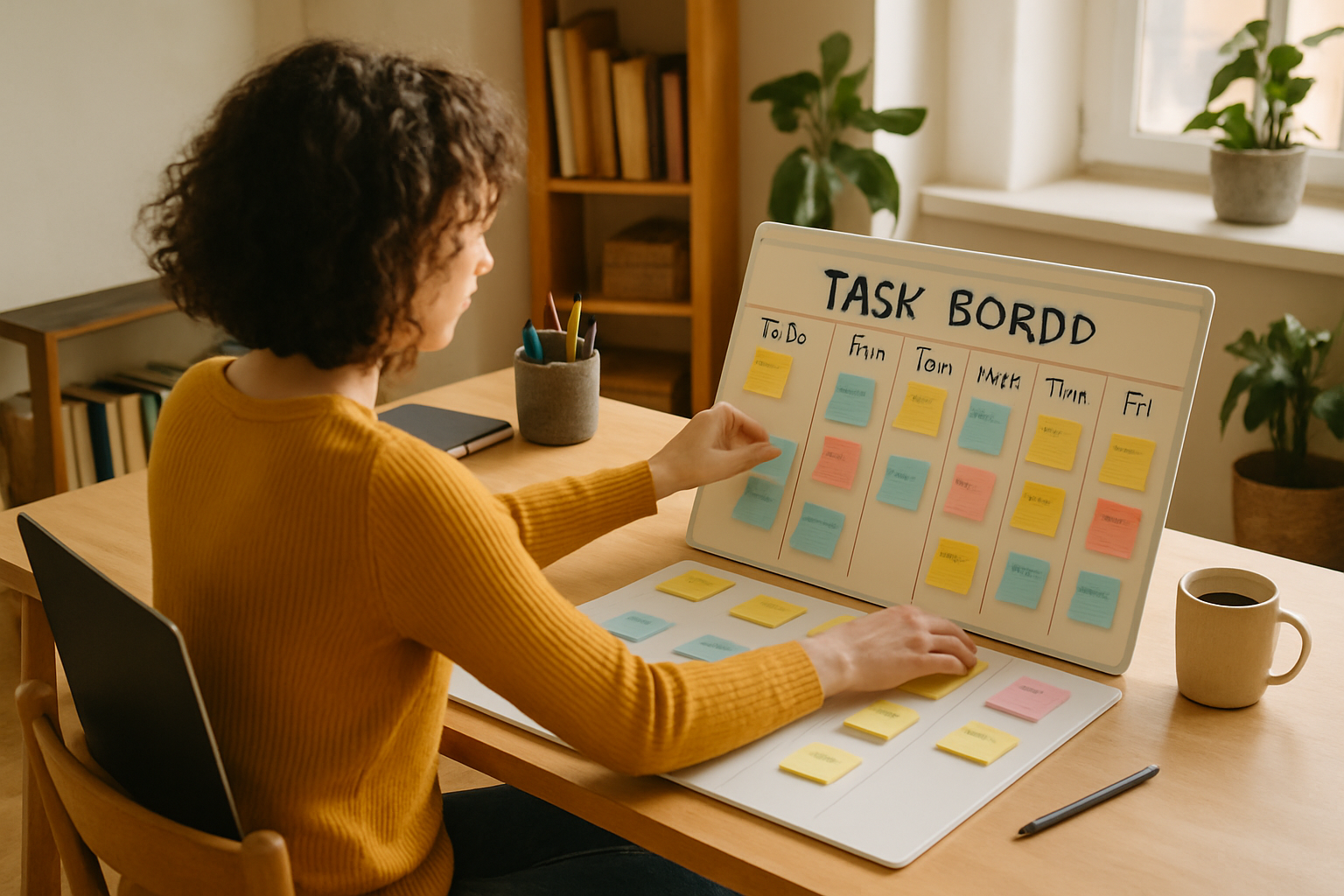
Task batching for ADHD brains
In today’s fast-paced digital world, the ability to manage distractions is not just an advantage—it’s a necessity. For neurodivergent individuals, especially those with ADHD, the struggle to stay focused can be intense and exhausting. Yet, within this challenge lies an opportunity: adopting task batching as a transformative tool for managing work, learning, and even everyday life.
Understanding Task Batching: More Than Just a Productivity Hack
Task batching is a strategy where similar tasks are grouped together and completed in dedicated blocks of time. Instead of constantly switching between different types of activities—coding, replying to emails, brainstorming, or attending meetings—you batch each category and address them in focused intervals. This minimizes context switching, a known productivity killer, and maximizes cognitive resources.
“For ADHD brains, the chaos of constant switching isn’t just distracting—it’s overwhelming. Task batching creates islands of structure in a sea of unpredictability.”
While this approach is beneficial for everyone, its impact is particularly profound for those with ADHD. The ADHD brain often thrives on novelty but can become quickly fatigued by repeated interruptions. Task batching leverages the brain’s tendency to hyperfocus, allowing for deep dives into one category of work before transitioning to another.
Why Task Batching Suits the ADHD Mind
The neurological underpinnings of ADHD mean that the brain’s executive functions—such as planning, organizing, and prioritizing—can sometimes lag behind. Task batching acts as a cognitive scaffold, supporting these functions by reducing the number of decisions required throughout the day.
Imagine starting your morning with a flurry of Slack messages, followed by a technical deep dive, then a quick switch to a meeting, and back to code reviews. For neurotypical brains, this is merely tiring. For someone with ADHD, it can be paralyzing. Task batching cuts through this noise:
- Fewer transitions. Less time is lost moving between different mental states.
- Clear boundaries. Well-defined intervals for each batch reduce anxiety and the fear of forgetting tasks.
- Increased momentum. Completing similar tasks in succession builds confidence and a sense of accomplishment.
Implementing Task Batching: A Practical Guide
Introducing task batching into your daily routine doesn’t require a major overhaul—just a shift in approach. Here’s how ADHD learners can start:
1. Identify Categories
Begin by breaking your responsibilities into categories such as communication (emails, messages), technical work (coding, designing), meetings, and administrative tasks (forms, scheduling). The more granular your categories, the easier it will be to batch them effectively.
2. Allocate Dedicated Time Blocks
Assign specific times in your day or week to each category. For instance, reserve 9-10 AM for answering emails, 10-12 for project work, and 2-3 PM for meetings. Use digital calendars or visual planners; color-coding can be especially helpful for neurodivergent minds.
3. Set Clear Boundaries
During each batch, focus exclusively on the tasks within that category. Turn off notifications for unrelated work. If you’re coding, close your email tab. If you’re in a communication block, avoid opening your IDE.
4. Start Small and Adjust
Don’t try to batch your entire workload immediately. Experiment with one or two categories at first, and observe how your energy and attention respond. Gradually increase as you grow more comfortable.
“Task batching isn’t about rigid schedules, but about honoring your attention and giving your brain the environment it needs to flourish.”
Task Batching in Tech: Real-World Applications
For women and other underrepresented groups in tech, the pressure to multitask can be especially intense. The expectation to be always-on—balancing technical tasks with emotional labor, mentorship, and advocacy—can quickly lead to burnout. Task batching provides a framework to reclaim control over your schedule and mental bandwidth.
Consider a software engineer who juggles code reviews, sprint planning, mentorship sessions, and company-wide initiatives. By batching mentorship sessions into a specific afternoon each week, and allocating uninterrupted mornings for deep technical work, she can bring her best self to each domain. This not only improves performance but also reduces the emotional toll of constant multitasking.
Learning, Neurodiversity, and Batching
In educational settings, ADHD learners often feel out of sync with traditional methods. The pressure to conform to a linear, multitasking model can be alienating. Educators who encourage batching—such as grouping similar assignments or allowing students to block out time for reading versus problem-solving—support neurodiverse learning styles.
For example, in a coding bootcamp, students might batch hands-on programming labs in the morning and reserve afternoons for theory and group discussions. This aligns with the natural ebb and flow of attention, maximizing both retention and engagement.
Essential Tools for Task Batching
Technology can be both a blessing and a curse for ADHD learners. However, the right digital tools can make task batching intuitive and enjoyable:
- Calendar apps like Google Calendar or Outlook for time-blocking.
- Task managers such as Todoist or Trello for categorizing and tracking batches.
- Focus apps like Forest or Freedom to minimize external distractions during each batch.
- Visual timers (Pomodoro-style) to provide a sense of urgency and closure for each block.
For those who find digital tools overwhelming, a simple paper planner with colored markers can be just as effective. The key is to create a system that feels supportive, not restrictive.
“The best batching system is the one you’ll actually use. It should feel like a gentle nudge, not a straitjacket.”
Addressing Common Challenges
Adopting a new workflow isn’t always smooth, especially for ADHD brains that may resist routine. Here are some gentle approaches to common barriers:
- Perfectionism: Don’t wait for the perfect system. Start with what you have, iterate, and forgive slip-ups.
- Task aversion: Batch the most challenging tasks during times of peak energy or after a motivating activity.
- Interruptions: Communicate your batching schedule to colleagues or family. Use “do not disturb” signals or notifications.
- Fatigue: Build in buffer time between batches. Short breaks are not a luxury, but a necessity.
Task Batching, Career Growth, and Wellbeing
For women, nonbinary professionals, and underrepresented groups in technology, career development is often as much about managing energy as acquiring skills. Task batching is not just a productivity tool, but a way to nurture your mind and protect your creativity from the constant demands of modern work.
By giving yourself permission to focus deeply on one thing at a time, you create space for innovation and reflection. This is particularly vital in technology, where breakthroughs rarely come from scattered attention. Instead, they emerge from sustained periods of thought, experimentation, and iteration.
For those mentoring neurodivergent learners, advocating for batching is a gift. It signals respect for different ways of working and learning, and promotes an inclusive environment where all brains can thrive.
“In a world that celebrates multitasking, honoring single-task focus is a quiet act of rebellion—and self-respect.”
Building a Supportive Culture
Task batching is most effective when it’s supported by your environment. Teams that schedule meetings in dedicated blocks, provide notification-free work periods, and normalize boundaries help everyone—not just those with ADHD—perform at their best.
Leaders in tech and education can set the tone by modeling batching themselves. Sharing your own batching routines, inviting feedback, and making space for neurodiverse practices builds trust and psychological safety.
Embracing Your Brain’s Strengths
Ultimately, task batching is about working with your brain’s natural rhythms—not against them. For ADHD learners and professionals, this approach can be life-changing. It transforms chaos into coherence, exhaustion into energy, and self-doubt into self-trust.
As technology continues to reshape how we work and learn, the ability to adapt our methods to fit our minds will be more important than ever. Task batching is a gentle, effective way to support focus, creativity, and wellbeing—one carefully crafted block at a time.


